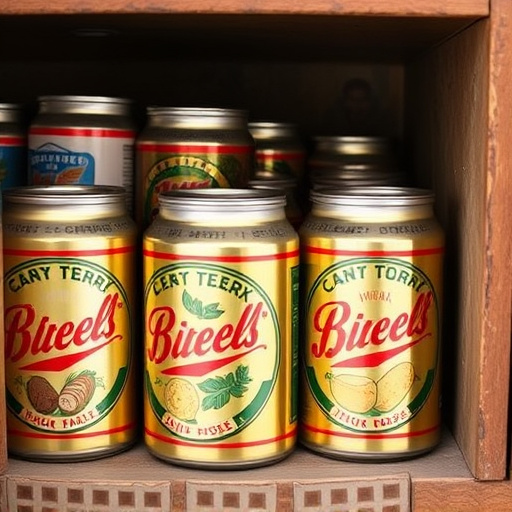Counterfeit food products, especially peanut butter, pose health risks due to substandard ingredients and packaging. Fake Peanut Butter Security Containers protect against tampering by employing advanced locking, robust construction, digital codes, biometric access, and GPS tracking. Store these fakes in non-porous, airtight containers for hygiene and durability. Implement strategic security measures like locked cabinets, biometric locks, regular maintenance, and updated industry tech to safeguard authentic products.
In today’s market, consumers face an increasing risk of purchasing counterfeit goods, including seemingly innocuous items like peanut butter containers. Fake peanut butter security containers not only pose health risks but also threaten the integrity of genuine brands. This article delves into understanding the dangers of fake products, exploring key features for secure storage solutions, and emphasizing material safety for food. We’ll guide you through best practices to implement effective security measures, ensuring peace of mind when storing and selling peanut butter and similar everyday essentials.
- Understanding the Risks of Fake Peanut Butter Containers
- Key Features for Secure Storage Solutions
- Choosing the Right Material for Food Safety
- Implementation and Best Practices for Effective Security
Understanding the Risks of Fake Peanut Butter Containers
The rise of counterfeit goods has become a significant concern in the food industry, particularly with everyday products like peanut butter. When it comes to storage, using a secure fake peanut butter container is essential to mitigate potential risks. Consuming fake or tampered-with food products can lead to severe health issues and even legal complications for unsuspecting buyers. These counterfeits often lack proper safety standards, using subpar ingredients and packaging that may not safeguard the product’s integrity.
Moreover, counterfeiters might employ clever tactics to mimic genuine containers, making it challenging for consumers to discern the real from the fake. This is particularly worrying as peanut butter, being a staple in many households, requires adequate security measures to ensure its authenticity. By opting for secure storage solutions designed for fake peanut butter containers, consumers can rest assured that their purchases are safe and conform to quality standards, thereby protecting both health and wallet.
Key Features for Secure Storage Solutions
When it comes to safeguarding your valuable or sensitive items, a secure storage solution is essential. For those dealing with fake everyday products like peanut butter, a specialized container becomes an indispensable tool. Key features to look for include advanced locking mechanisms that prevent unauthorized access, robust construction to withstand tampering, and a design that offers both discretion and high visibility to deter theft.
Additionally, digital security codes or biometric access control systems enhance safety measures, ensuring only authorized personnel can open the container. Some models even incorporate GPS tracking, enabling real-time location monitoring for added peace of mind. A Fake Peanut Butter Security Container, designed with these features, provides an effective shield against counterfeiting and ensures the integrity of your products.
Choosing the Right Material for Food Safety
When selecting a secure storage container for fake everyday products, like a fake peanut butter jar, material safety is paramount, especially if it’s intended for food storage. Opting for materials that meet food-safe standards is crucial to prevent any potential contamination or adverse health effects. Glass and stainless steel are popular choices due to their non-porous surfaces, which inhibit bacteria growth.
For added security, consider containers with airtight seals designed to lock in freshness and keep out intruders. This is especially important for imitations of perishable items like peanut butter, where maintaining proper hygiene is key. Ensure the container is also durable enough to withstand regular use and potential rough handling, ensuring the integrity of its seal remains intact.
Implementation and Best Practices for Effective Security
Implementing effective security measures for storing fake everyday product containers, such as a Fake Peanut Butter Security Container, involves a multi-faceted approach. Begin with selecting robust storage solutions designed to prevent tampering and unauthorized access. High-quality, locked cabinets or secure safe deposit boxes can significantly deter potential thieves, ensuring your products remain intact. Additionally, incorporating advanced technology like biometric locks or motion sensors adds an extra layer of protection.
Best practices dictate regular maintenance and monitoring. Keep records of all stored items, including detailed descriptions and quantities, for easy inventory checks. Implement a structured access protocol, limiting entry to authorized personnel only. Regularly update security protocols and stay informed about industry standards and innovations in fake product storage technology, such as specialized RFID tagging or digital tracking systems, to maintain optimal security for your Fake Peanut Butter Security Container and other everyday items.
In conclusion, securing your supply chain from counterfeit goods, particularly in everyday products like peanut butter containers, is a multifaceted challenge. By understanding the risks, selecting secure storage solutions with key features, choosing safe and food-grade materials, and implementing best practices, you can protect consumers and preserve brand integrity. A robust Fake Peanut Butter Security Container is not just an investment; it’s a safeguard against potential health hazards and financial losses, ensuring peace of mind in an increasingly complex market.
